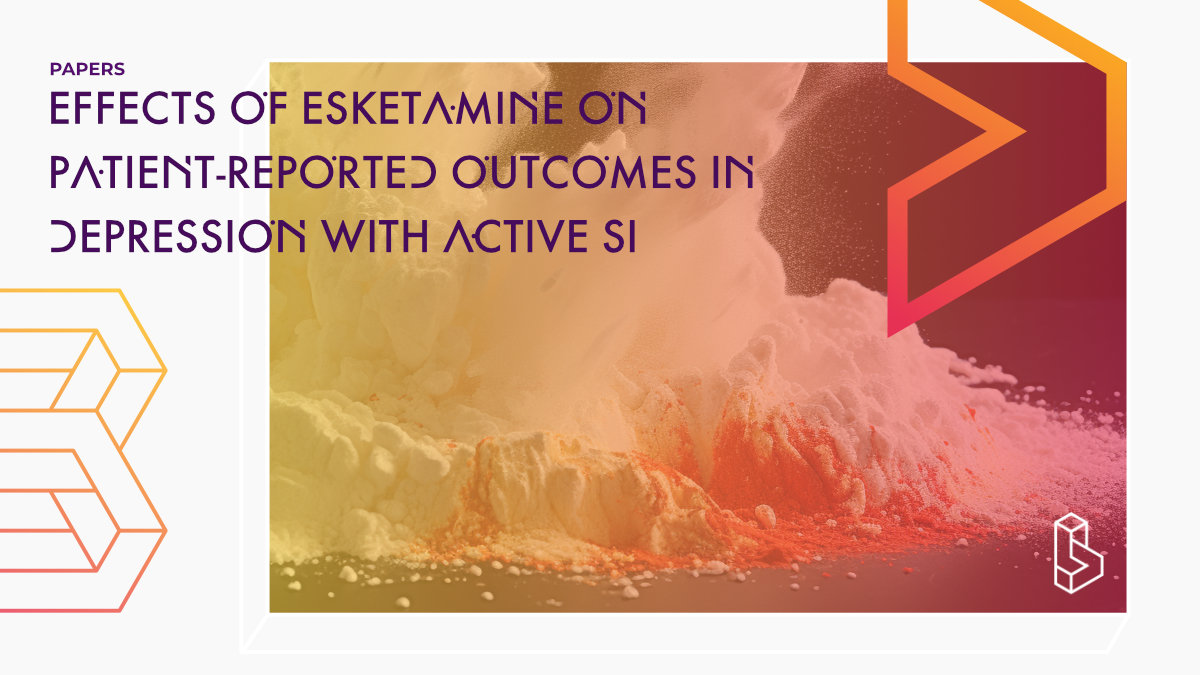This pooled analysis of two Phase III studies (n=451, ASPIRE) investigates the effect of esketamine nasal spray plus standard of care on patient-reported outcomes in patients with major depressive disorder (MDD) having active suicidal ideation (SI) with intent. It found that esketamine, compared to placebo, led to significant improvements in Beck Hopelessness Scale (BHS) and Quality of Life in Depression Scale (QLDS) scores, along with perceptions of effectiveness and global satisfaction in the Treatment Satisfaction Questionnaire for Medication (TSQM-9), supporting its positive impact on health-related quality of life in this patient population.
Abstract of Effects of esketamine on patient-reported outcomes in depression (MDD) with active suicidal ideation (SI) and intent
“Purpose To assess the effect of esketamine nasal spray on patient-reported outcomes (PROs) in patients with major depressive disorder having active suicidal ideation with intent (MDSI).
Methods Patient-level data from two phase 3 studies (ASPIRE I; ASPIRE II) of esketamine + standard of care (SOC) in patients (aged 18–64 years) with MDSI, were pooled. PROs were evaluated from baseline through end of the double-blind treatment phase (day 25). Outcome assessments included: Beck Hopelessness Scale (BHS), Quality of Life (QoL) in Depression Scale (QLDS), European QoL Group-5-Dimension-5-Level (EQ-5D-5L), and 9-item Treatment Satisfaction Questionnaire for Medication (TSQM-9). Changes in BHS and QLDS scores (baseline to day 25) were analyzed using a mixed-effects model for repeated measures (MMRM).
Results Pooled data for esketamine + SOC (n = 226; mean age: 40.5 years, 59.3% females) and placebo + SOC (n = 225; mean age: 39.6 years, 62.2% females) were analyzed. Mean ± SD change from baseline to day 25, esketamine + SOC vs placebo + SOC (least-square mean difference [95% CI] based on MMRM): BHS total score, − 7.4 ± 6.7 vs − 6.8 ± 6.5 [− 1.0 (− 2.23, 0.21)]; QLDS score, − 14.4 ± 11.5 vs − 12.2 ± 10.8 [− 3.1 (− 5.21, − 1.02)]. Relative risk (95% CI) of reporting perceived problems (slight to extreme) in EQ-5D-5L dimensions (day 25) in esketamine + SOC vs placebo + SOC: mobility [0.78 (0.50, 1.20)], self-care [0.83 (0.55, 1.27)], usual activities [0.87 (0.72, 1.05)], pain/discomfort [0.85 (0.69, 1.04)], and anxiety/depression [0.90 (0.80, 1.00)]. Mean ± SD changes from baseline in esketamine + SOC vs placebo + SOC for health status index: 0.23 ± 0.21 vs 0.19 ± 0.22; and for EQ-Visual Analogue Scale: 24.0 ± 27.2 vs 19.3 ± 24.4. At day 25, mean ± SD in domains of TSQM-9 scores in esketamine + SOC vs placebo + SOC were: effectiveness, 67.2 ± 25.3 vs 56.2 ± 26.8; global satisfaction, 69.9 ± 25.2 vs 56.3 ± 27.8; and convenience, 74.0 ± 19.4 vs 75.4 ± 18.7.
Conclusion These PRO data support the patient perspective of the effect associated with esketamine + SOC in improving health-related QoL in patients with MDSI.”
Authors: Carol Jamieson, Carla M. Canuso, Dawn F. Ionescu, Rosanne Lane, Xin Qiu, Heather Rozjabek, Patricio Molero & Dong-Jing Fu
Summary of Effects of esketamine on patient-reported outcomes in depression (MDD) with active suicidal ideation (SI) and intent
Depression affects nearly 300 million people globally and is a major contributor to suicide deaths. Individuals with MDD and suicidal ideation have poorer health-related quality of life, work productivity loss and activity impairment.
The current standard of care includes inpatient psychiatric hospitalization and optimized oral antidepressant therapy for patients at risk for suicide. However, the risks of suicide remain high following discharge.
Find this paper
https://doi.org/10.1007/s11136-023-03451-9
Open Access | Google Scholar | Backup | 🕊
Cite this paper (APA)
Jamieson, C., Canuso, C. M., Ionescu, D. F., Lane, R., Qiu, X., Rozjabek, H., ... & Fu, D. J. (2023). Effects of esketamine on patient-reported outcomes in major depressive disorder with active suicidal ideation and intent: a pooled analysis of two randomized phase 3 trials (ASPIRE I and ASPIRE II). Quality of Life Research, 1-9.
Study details
Compounds studied
Ketamine
Topics studied
Depression
Suicidality
Study characteristics
Placebo-Controlled
Double-Blind
Randomized
Re-analysis
Participants
451
Humans
Institutes
Institutes associated with this publication
Johnson & JohnsonOne of the largest pharmaceutical companies in the world, Johnson & Johnson are responsible for bringing esketamine to market in the form of Spravato.
Compound Details
The psychedelics given at which dose and how many times
Ketamine 84 mg | 8x
